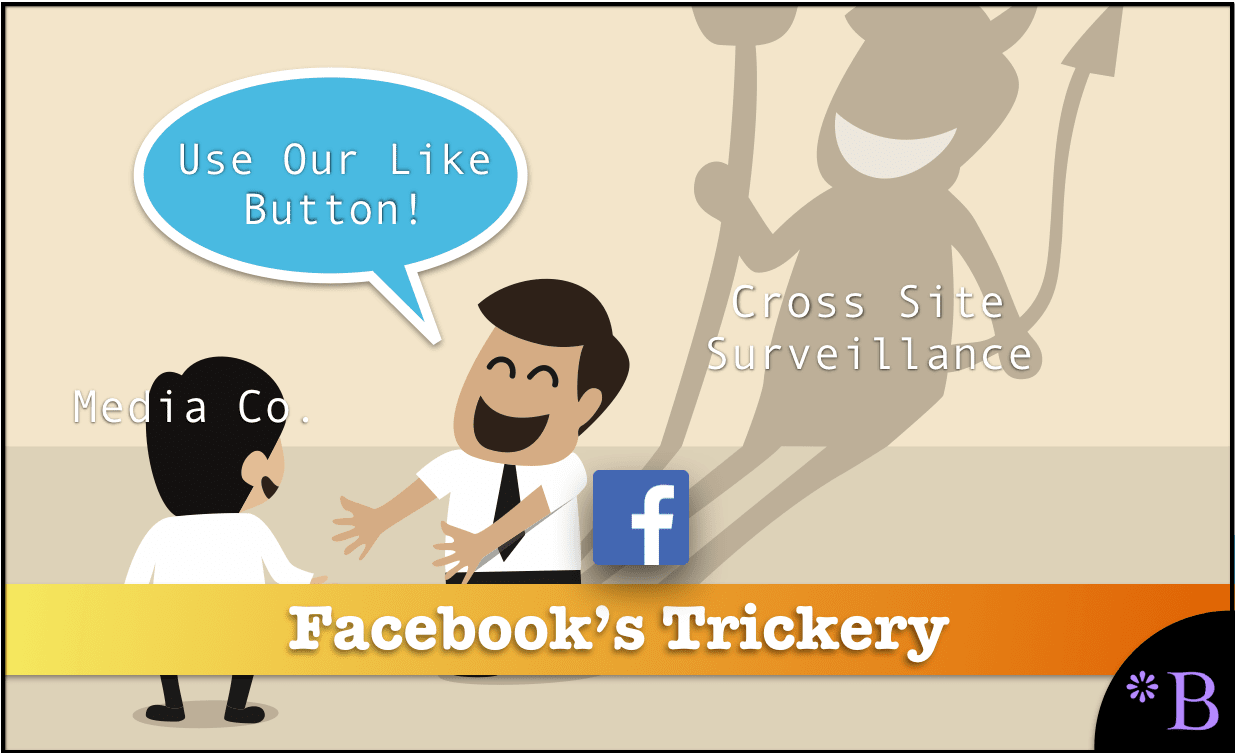How Facebook Tricked its Media Partners into Surveillance with the Like Button
Executive Summary
- Facebook designed a system to allow them to track Facebook users across websites.
- Facebook tricked its media partners with the media Like button.

Introduction
As Facebook faces a DOJ lawsuit for monopolistic behavior, what will happen is Facebook’s business model will be highlighted to more of a degree than before. Facebook has a long history of tracking and surveilling its users while on Facebook and across other websites.
Our References for This Article
If you want to see our references for this article and other related Brightwork articles, see this link.
Facebook’s Media Like Button
Dina Srinivasan does an excellent job explaining how LinkedIn introduced a like button that Facebook liked to media companies about how this like button, placed on their websites, enables Facebook to perform cross-website tracking.
Facebook Introduces Beacon Part Deux: The Media Like Button
In 2007, Facebook introduced Beacon, which was a surveillance system, which was eventually found to be doing things that Facebook lied about it does. However, in 2010, Facebook introduced surveillance technology, but now it brought media companies into helping with the surveillance. This was the like button that would be placed on the media company’s web pages.
The relevant history of Facebook social plugins centers around the “Like” button—
introduced early in 2010, at Facebook’s annual F8 developer conference. The Facebook Like buttons, and even the Login buttons, are products offered to publishers and other independent businesses to improve site functionality and increase revenue. For publishers, the Like buttons, offered a turn-key review and distribution mechanism. Facebook explained, “[e]ach Like creates distribution on Facebook, which brings more Facebook users back to the article on your site.” Because online publishers generate incremental revenue for each click on an article, more user visits meant more money. According to Facebook, the installation of social plugins increased traffic on average by 200%. Thousands of publishers (competitors of Facebook for digital ad dollars), and other websites and apps, hoping for incremental ad revenue, flocked to install the Facebook Like button. All a third-party had to do was install a single line of HTML Facebook code into their application. Within the first week of availability, more than 50,000 sites added social plugins. CNN, The New York Times, The Wall Street Journal, Slate, and ABC were among the many initial adopters. Facebook social plugins opened a vulnerability between users’ devices and Facebook’s servers much in the same way that Beacon did a few years earlier. Like Beacon, social plugins required independent businesses to install Facebook code on their websites, which opened a backdoor communication between users’ devices and Facebook’s servers.
This drives the point home that Facebook could not have created its monopoly or developed its surveillance system without cooperating with media’s biggest names. This brings up a question: how are these media entities now going to report on the monopolistic behavior and surveillance of users, as they were in on it?
In their defense, Srinivasan asserts that many of these entities did not understand the technical implications of what they were doing with the Like button and that it even worked against their monetization interests. And naturally, Facebook did not tell them.
Did Facebook Trick its Media Partners to Add the Media Like Button?
The evidence supporting this contention is that media entities did something bad for their own long term interests by agreeing to include Facebook’s Like button on their content.
But Facebook’s claims were also important in soliciting the coordination of third-parties to spread the presence of Facebook code across the internet. Many third-parties, publishers for example, competed with Facebook on the advertising side of the market.
They licensed and installed social plugins as a means to distribute their own content. Surveillance of their own readers, however, could be used against them to undercut the value of and pricing power over their own proprietary readers.
Specifically, if Facebook could compile a list of people that read the Journal, even those who did not use Facebook, it could simply sell the ability to retarget “Journal readers” with ads across the internet for a fraction of the cost that the Journal charged.
When Zuckerberg first announced the Like buttons at the 2010 developer’s conference,
he did not mention that Like buttons could be used to track users. (emphasis added)Proprietary access to subscribers and the identities of readers and visitors is a highly
guarded asset historically by subscription businesses. It is unlikely that publishers would have
shared this information unless they were under the belief that Facebook was a content
distribution platform and traffic generator, not a surreptitious aggregator of consumer data for
Facebook’s own internal, and competitive, advertising sales efforts. Facebook obtained the initial cooperation of third-party businesses through the inducements of content distribution and the convenience of single login. Now Facebook would receive the ability to monitor the behavior of their customers—competitors with Facebook in the digital advertising market—by changing the fine print of permissions.Facebook increasingly knew as much about The Wall Street Journal’s readers as the Journal did itself. Furthermore, unlike the Journal, Facebook now knew which Journal readers were avid ESPN readers, giving it the capability to bundle and sell targeted audiences, which further commoditized the value of competitors’ inventory.
This is how consumers went from having a preference of privacy to having nearly every
competitor in the market extract from them identical and uniform consent for Facebook’s
commercial surveillance practices.
This has been part of a long-term social media pattern to usurp media entities, which is a topic we cover in the article How to Understand Big Tech’s Degradation of Media.

Facebook receives our Golden Pinocchio Award for how it lied to about the media Like button.
Conclusion
The degree of deception by Facebook regarding its Like button is overwhelming. It not only tricked readers of media sites but likely tricked many of the media entities themselves into including the button and thus becoming pawns of Facebook.
Due to Facebook’s cross-site tracking capability, it enlisted media to provide them with information that could be sold to advertisers that would be far more valuable than what each media entity could accumulate on their own.
This is yet another reason Facebook and Google have consumed most of the new online advertising revenues. This is explained in the following quotation:
The U.S. internet advertising market grew 21.8% in 2016 and 21% in 2017.
Facebook and Google accounted for over 99% and over 90% of that growth in 2016 and 2017, respectively. – Srinivasan
This means that nearly all of the growth in Internet advertising is going to just two companies. It should be remembered that neither Facebook nor Google produces content. Rather they point to content. However, by consuming nearly all of the growth in advertising revenues, they are surveilling users and undermining the media system.
Dina Srinivasan receives our score of 10 out of 10 for accuracy.